The Scenarios for the Future on Wind Energy in the World.
Posted by Jeroen van Agt in Wind energy 2 Comments»The worldwide market for wind energy has been growing faster than any other form of durable energy. Its installed power grew from only 4,800 MW in 1995 to 59,000 MW at the end of 2005. That is an increase of more than 1200 % in ten years. In the mean time, there are three scenarios worked out about how we can further expand wind energy and what benefits this will bring.
The results are impressive. In the expanding scenario we could deliver 34 % of our electricity with the help of wind energy by 2050. The cost price of wind energy could drop to 3 cents / kWh, the amount of jobs in wind energy will result in a growth of 2.1 million and the CO2 emissions decrease by 3,100 million tons…

The Status of Wind Energy in the World.
The worldwide market of wind energy has grown faster than any other durable energy market. The total installed power was only 4,800 MW in 1995, and became 59,000 MW at the end of 2005. That is an increase of more than 1,200% in ten years time.
Installed Wind Energy Power in the World
The expectation is that in 2006 the turnover of the international market will be more than 13 billion € per year with an estimated 150,000 jobs in this sector worldwide.
In a number of countries, the amount of generated wind power competes with the traditional electricity generation already; in Denmark 20 % of the electricity is generated with wind power, in Spain 8 % and will grow to an estimated 15 % in 2010.
These numbers show that wind energy can contribute significantly to a “carbon free” electricity generation, meaning without the use of fossile raw materials and CO2 emission.
In 2005 the worldwide energy sector has established a new record with a total of 11,531 MW of new installed capacity. This equates to a yearly increase of 40.5 % and a cumulative grow of 24 %.
New Installed Wind Energy Power in 2005
Wind energy is readily available as an energy source in more than 50 countries in the world. In the following table I present an overview of countries with the biggest amount of it in 2005.
| Country | Power (MW) |
|---|---|
| Germany | 18,428 |
| Spain | 10,027 |
| USA | 9,149 |
| India | 4,430 |
| Denmark | 3,122 |
A number of countries, such as Italy, UK, The Netherlands, China, Japan and Portugal reached the level of 1,000 MW.
Where originally, the European Union countries were most active in wind energy, this is now changing. In the USA and in Canada, there is more activity going on in this field, while new markets are emerging in Asia and South America.
The Drive behind Wind Energy
A few important factors were responsible for the growth of the wind energy market. This resulted also in a political support of wind energy development in some regions in the world.
To assure the offer of energy: due to the absence of expected energy saving measures, the International Energy Agency (IEA) expects that the world energy consumption in 2030 will be 60% higher than today, meanwhile, the availability of fossil fuels decreases. Some big economies in the world are more dependent on the import of fuels, sometimes from regions in this world where conflicts and political instabilities can endanger the availability of these fuels. Wind energy, meanwhile, is available everywhere in the world.
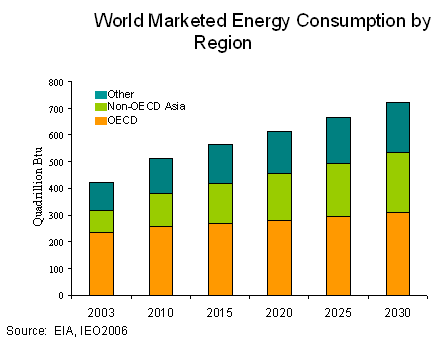
Rising Demand for Energy
Environmental effects: An important factor behind the growth of wind energy is the urgent need to do something to offset climate change. Now it is generally acknowledged that this is the biggest environmental threat of the world. In the 97 Kyoto Protocol, it has been agreed that all OECD country members will decrease their CO2 emissions bz an average of 5.2%. However in third world countries there are more urgent problems coming from direct environmental effects due to burning of fossile fuels, mainly from air pollution.
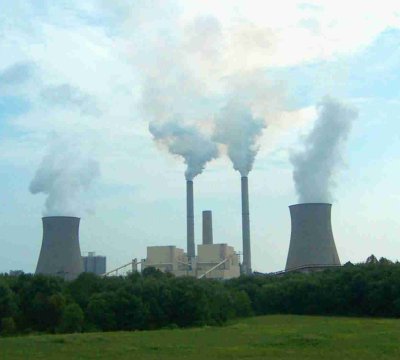
Energy Generation with a Coal Power Plant
Other environmental effects caused by the use of fossile fuels and the burning of it to generate electricity are the destruction of landscape, pollution of ground water and health risks for the population due to irradiation. By using endurable energy sources these risks can be avoided.
The economy: Thanks to the growth of the wind energy market, the costs for wind energy have
decreased considerably. A modern wind turbine produces annually 200x more energy for half of the cost of an equivalent wind turbine 20 years ago. At good wind locations wind energy can compete on
a cost basis with coal – as well as gas power plants. Wind energy will become cheaper when compared to fossil fuels due to the price increase of the latter. If we take into account the environmental costs that relate to the burning of fossil fuels, such as increased health costs, ground water poisoning, climate change due to buildup of CO2 then wind energy is already cheaper.
Wind energy has also created new jobs, and in developing countries “off-grid” wind energy creates economical possibilities for distributed communities.
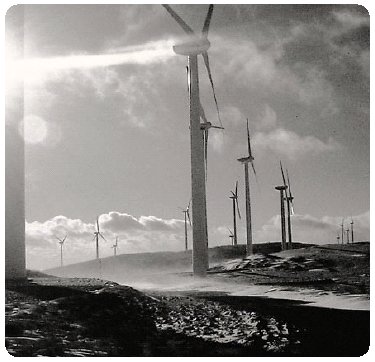
Deserted Off-grid Wind Turbines
Technology and Industry: Since 1980, when the first commercial wind turbines were placed, we have seen a huge inprovement in their efficiency and design. As said before, a modern wind turbine produces 200x more at half the cost compared to an equivalent wind turbine 20 years ago. At the time of writing, the biggest wind turbines nowadays produce more than [6 MW](http://www.enercon.de/en/e112.htm) and have blade length of about 70 m (resulting in a diameter of 100 meters).
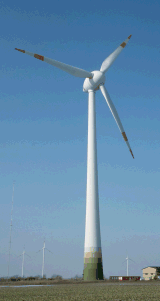
Enercon E-112 windturbine
The technological progress in the last 25 years has resulted in the modern state-of-the-art wind turbines that are installed in a modular and efficient way. The wind parks vary in size from a couple of MW to several hundredths. The biggest wind turbine producers invest millions in factories all over the world to satisfy the demand.
The Wind Sources and Integration in the Electricity Grid.
Studies done to identify the wind sources confirm that these are indeed vary big and distribute easily over all regions and countries. A shortage on wind is improbably a limiting factor for worldwide energy developments. While the wind industry grows, we need to couple the increasing wind energy production to the worldwide electricity network.
Variation in wind energy does not pose problems for such integration. The adjustment possibilities and spare capacity that are already present cope with variations in energy demand and are capable of dealing with the additional variation of the wind energy, as long as it is less than 20 % of the total energy capacity. When contribution becomes bigger than 20 %, some adjustments in current energy systems need to be made. Improved forecast techniques and bigger geographical spread of wind turbines will help in this integration.
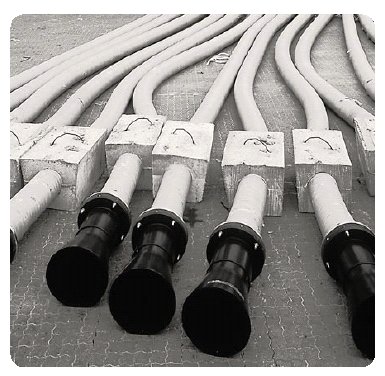
Improvements to the infrastructure is needed at integration of more than 20 % wind energy
The potential of integrating big quantities of wind energy is seenin Danemark where already 20 % of their total electricity consumption is generated with wind energy. The DENA study (pdf) in Germany concludes that wind energy can increase with a factor of three by 2015, leading to 14% of the total electricity consumption, without the necessity of additional reserves or balancing power plants.
The Influence of Wind Energy on the Environment.
When placing wind turbines, often in open areas, the following issues are of importance: the change of landscape, noise, and the effect on animals and nature. These issues are dealt with in an environmental impact analysis report.
The view on the landscape
Wind turbines often are tall constructions highly visible in a big area. While some people call them pollution of the landscape, others see them as elegant and stylish, being the symbol for a less polluting future.
Birds
Influence on birds can be: loss of territory, disturbance of their breeding locations and the danger of death when colliding with rotoblades. Studies done in Europe and the USA show that the average chance of a collision is no more than 2 birds per wind turbine per year. See these numbers in comparison with the millions of birds dying due to electricity cables, pesticides and traffic.

The most important unnatural death causes of birds in the USA
Noise
Compared to traffic transit, trains, construction activities and other noise sources from industry, the noise generated by wind turbines is relatively low.
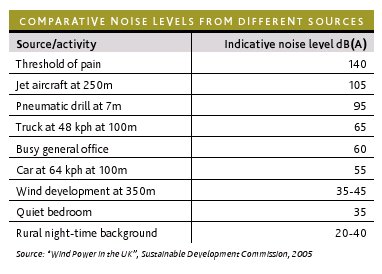
The noise level of different noise sources
Better designs and better noise isolation have made the newest turbines much quieter. Legislation prescribes that turbines need to be placed sufficiently far away from homes to minimize the inconvenience.
Future Scenarios for Wind Energy in the World
The ‘Global Wind Energy Outlook Scenario’ studies the wind energy potential until year 2050. There are three different scenarios:
- The reference scenario based on the numbers from the ‘International Energy Agency’ (IEA).
- A moderate scenario assuming that the current targets for durable energy will be successfull.
- An advanced scenario that assumes that for all energy options the policy is to choose the durable solution.
These three scenarios will be held against the two scenarios for world wide energy need.
- In the reference scenario, the growth of the energy demand is based on future predictions of the IEA.
- In the high energy efficiency scenario a number of energy efficiency measures result in a huge reduction of demand for energy.
The results show that wind energy can deliver an important part in the worldwide demand for clean, durable electricity in the coming 30 years. The results also show that this part will increase while at
the same time serious energy efficiency measures are taken that reduce the overall need for energy.
The results of the different scenarios are found in the following table
Results of the Different Scenarios
All three scenarios assume that a growing part of the new wind energy capacity will be installed in such growth markets as South-America, China, India and South-Asia.
The Costs and Advantages of the Different Scenarios
Investments: The yearly investment in the wind energy market in 2030 will vary from € 21,2 billion in the reference scenario to € 45 billion in the moderate scenario to € 84,8 billion in the advanced scenario.
Generation Costs: The costs to generate electricity with wind energy will, as expected, fall to 3-3.8 €-cent/kWh at a good wind location and 4-6 €-cent/kWh at a location with low average windspeed.
Jobs: The amount of jobs that will be created in the wind energy market will vary from 480,000 in 2030 in the reference scenario to 1.1 million in the moderate scenario and up to 2.1 million in the advanced scenario.
Savings on CO2 emissions: The savings will vary from a yearly 535 million tons CO2 in 2030 in the reference scenario to 1,661 million tons in the moderate scenario and up to 3,100 million tons in the advanced scenario.
Energy Politics and Recommendations
Durable energy sources are held back because the real costs of fossil fuels are not accounted for. The costs of capturing the CO2, the cleaning of ground water, the cleaning of air, but also the fact that we are burning our fossil fuels and not creating new energy generation possibilities, makes the price for fossil fuels only a political price and not the real price. As a result the price to be paid for energy from fossil fuels is too low and this keeps introduction of durable enrgy sources at a distance. The durable energy sources are our only future since they generate more energy than what they would costs us to create, maintain, operate and recycle.
Without political support wind energy will have a much harder job to support environmental goals and safeguard the energy supply in the future.
ACTION IS NEEDED IN THE FOLLOWING AREAS
Targets for the minimum amount of durable energy: Putting (challenging) targets will put governments to create supporting laws and regulations to expand the durable energy options, including the financial structures, connection to the electricity grid, planning and administrative processes.
Clear policy: The market for energy generation needs to be taken into account in landwide regulations, including stable long term fiscal measures that minimize risk for investers and that guarantee a good profit.
Restructuring of electricity market: Restructuring is needed in the electricity sector to promote durable energy options and to remove barriers to start in that market. Also, costs involving the cleaning up of pollution, and costs to safeguard energy for the future should be included in the fossil energy price.
International actions against climate change: The targets for reducing emissions of greenhouse gases must be establised for the period after the Kyoto period of 2008-12.
Restructuring international financing: Morefold-lateral finance mechanisms need to be defined that favor durable energy projects at the cost of fossile based ones.
Action by international organizations: The G8 countries and the United Nations commission for durable energy development must support the development of durable energy.
Background information
The complete report is available for download below:
GLOBAL WIND ENERGY OUTLOOK 2006 (pdf)
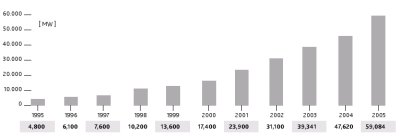

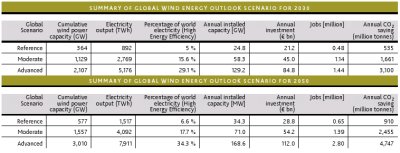





2 replies on “The Scenarios for the Future on Wind Energy in the World.”
I realy like this article, it is the best about renewable energy.”Wind” the invisible, fuel free, infinite supply and virgin but very powerful.I love the “Wind”. I hope 50 % of new power plants from now till 2020 shall be wind mill generation and after 2040 power plant from fossil and nuclear fuel shall be rubbed out from our lovely world.
Really very very helpful. I have learned many things from this site, thanks for these information.